Menus
- Model type SC28 to SC59
- Wheelies possible at any time
- Model history – SC28 to SC59
- Market situation for used Fireblades
- Waldemar Schwarz on the Honda Fireblade
- Conclusion
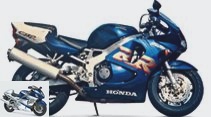
Frank Herzog.
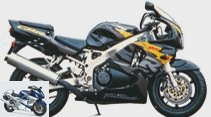



16 photos
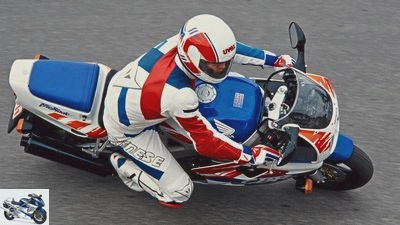
Frank Herzog.
1/16
The first: In 1992, Honda turned the world of supersports on its head.
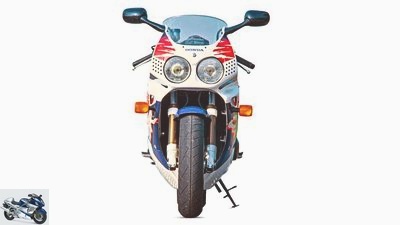
Frank Herzog.
2/16
1000 performance with 600 weight, sensational!
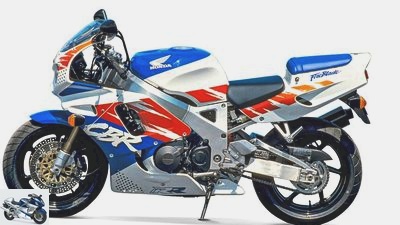
Frank Herzog.
3/16
Well-preserved, unscrewed SC28 blades are now rare.

Markus Jahn.
4/16
Honda Fireblade SC33: In 1996 the engine was expanded to 919 cc by boring.
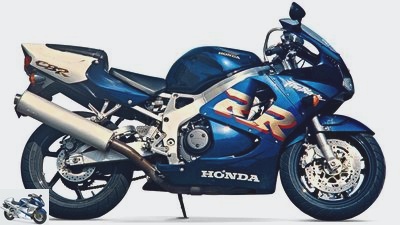
Markus Jahn.
5/16
Honda Fireblade SC33 II: 1999 was the last year of manufacture with carburettors.
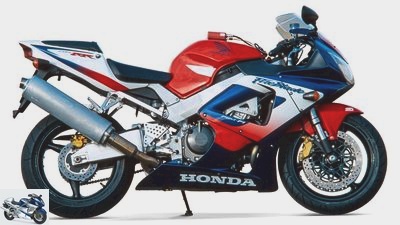
Rossen Gargolov.
6/16
Honda Fireblade SC44: In 2000 came a completely redesigned motorcycle with injection and 929 cc.

7/16
Honda Fireblade SC50: From 2002 modern look and now 150 hp from 954 cm³.
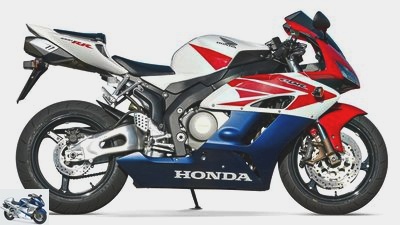
Markus Jahn.
8/16
Honda Fireblade SC57: From 2004 again a completely new motorcycle with underseat exhaust system and 998 cc.
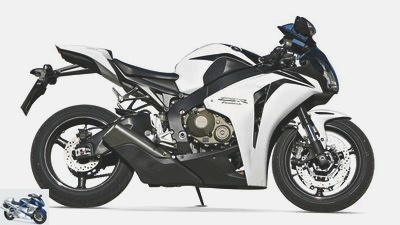
Jorg Kunstle.
9/16
Honda Fireblade SC59: In 2008 a completely newly developed model with a compact exhaust system appeared under the new and shorter-stroke engine.

MPS archive.
10/16
Waldemar Schwarz was one of the first journalists to test the new Honda Fireblade.

Frank Herzog.
11/16
The bearish 900 engine delivered well from the basement. So you could pull an important wheelie at any time.
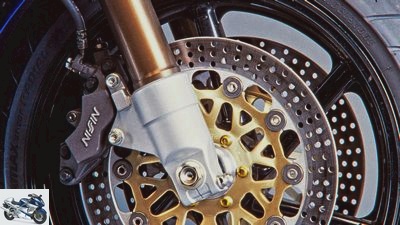
Frank Herzog.
12/16
Light Nissin brakes, annoying, wide 16-inch tires.

MPS archive.
13/16
Sporty cockpit, fairly dominant fairing holder.
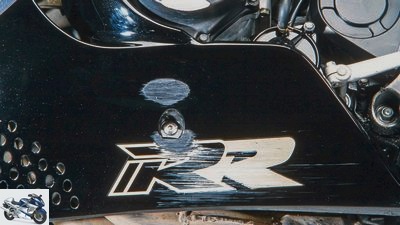
MPS archive.
14/16
Ground clearance too low for the race, Lima touches down dangerously.
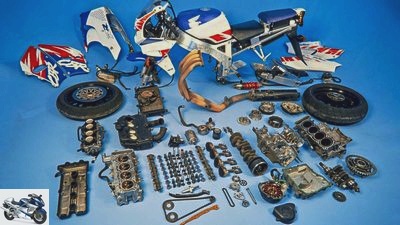
Uli Schwarz.
15/16
When buying a used vehicle, you should pay attention to a few things. It should be checked whether the bolted rear frame is straight. In addition, the shock absorber should not oil. In addition, the exhaust system should be checked for corrosion.
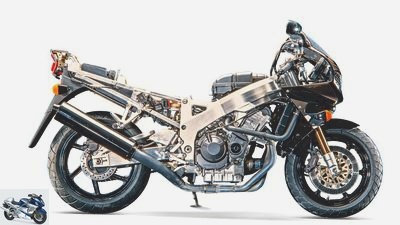
MPS archive.
16/16
Robust: The Honda held up in the endurance test. The attacked exhaust system was improved on later models.
Youngtimer check: Honda CBR 900 RR Fireblade
Model type SC28 to SC59
Content of
The Honda CBR 900 RR Fireblade ushered in a new era in the world of super athletes. In the youngtimer check we take a close look at the model types SC28 to SC59.
A warm spring day in Hockenheim, I’m driving the brand new one F.Ireblade from the PS transporter, half the paddock comes together. What can the new Honda do? Is it a tank like the Suzuki GSX-R 1100 or a lighter like a Yamaha FZR 600? Or does it have tank power with 600 handling, as promised? 124 hp meet 206 kilos, a sensational station wagon for 1992. The supersport-loving crowd looks after me with envy as I accelerate in the pit lane and speed towards the ant curve. And of course the fast ones, or those who think they are, take my rear wheel right away. Stress? No, normal back then. At the usual Monday training session, people met and burned more or less brisk laps in the rough Hockenheimer asphalt.
Wheelies possible at any time
First of all, the blade is stressful. The handlebar stubs turned far forward, the high seat, the short but wide tank, all unfamiliar. And somehow the Honda doesn’t want to go into corners the way I want it to. The first one is already pulling past, turning around with a smirk while I curse the wide and small front wheel. At the time, Honda was of the opinion that it would only go really fast with a 130 mm tire in the front. That might well work on smooth asphalt, but not at all on the Hockenheim beet field. The blade shakes itself in an inclined position on bumps, does not want to turn on the brakes. Even worse: it becomes very light at the front when accelerating and at the rear when braking. My braking point in front of the Sachskurve therefore almost mutates into a crash point, and the blade positions itself on the front wheel in a flash.
Frank Herzog.
The Fireblade has always been available for wheelies.
That was new. A clumsy GSX-R 1100 did everything good-naturedly, as did a long FZR 1000. Nothing stood on the front wheel and the heavy iron pulled their way through the curves like large ships. The Blade, on the other hand, was a very nervous racer that demanded a lot of gymnastics from its driver. Ass when braking backwards, bulge on the tank when accelerating, knees out before cornering, when accelerating in an inclined position, load the outer notch – the blade demanded the active racing driver. Then it worked with the lap times. The Blade was awesome on the street. You could pull a wheelie at any time. The bearish engine delivered power from the lower speed range, and you got used to the handling after 500 kilometers.
Model history – SC28 to SC59
Honda Fireblade SC28 (1992)
Frank Herzog.
Honda Fireblade SC28.
The original model, internal code SC28, with a black painted exhaust system appeared in 1992. Optionally available with 98 HP or 124 HP. In 1993, Honda gave the first Fireblade new colors. Slight technical revisions followed a year later: new front headlights, wider and higher windshields, panel brackets made of aluminum instead of steel. Brushed aluminum silencer. Fork now with 14-fold compression setting, new magnesium cylinder head cover. 0.4 liter larger oil volume for the engine. In 1995 the SC28 stole again in new colors.
Honda Fireblade SC33 (1996)
Markus Jahn.
Honda Fireblade SC33.
In 1996 there was a major facelift for the first time. Displacement increased to 919 cm³, higher compression, digital ignition system with throttle valve sensor. Four hp more power (128 hp). A narrower engine thanks to the new alternator, curved water cooler. Aerodynamically improved fairing and front fenders. After new colors in 1997, Honda sharpened the Fireblade again for 1998. 130 HP, a new type of composite material for the cylinder liners. More compact clutch, new cooler, manifold made of stainless steel, new rear swing arm, fork designed more rigidly with new aluminum triple clamp below. Brake disc diameter increased to 310 millimeters.
Honda Fireblade SC33 II (1999)
Markus Jahn.
Honda Fireblade SC33 II.
Last year of construction with carburetors. Since 1998, as mentioned, with 310 brake discs, more caster and a more upright seating position. 130 hp engine with innovative cylinder liners, slipper pistons. Lighter triple clamps, weight only 202 kilograms.
Honda Fireblade SC44 (2000)
Rossen Gargolov.
Honda Fireblade SC44.
Completely redesigned motorcycle with injection, 929 cm³ and finally 17-inch front wheel. Swing arm mounted on the engine, upside-down fork, stainless steel exhaust system with aluminum muffler, 330 mm brake discs. Nominal 147 hp.
Honda Fireblade SC50 (2003)
Honda Fireblade SC50.
From 2002 more modern optics and now 150 hp from 954 cm³. The chassis tended to hit the handlebars, even at high speeds. Was modified again in 2003. Elaborately built rear swing arm.
Honda Fireblade SC57 (2004)
Markus Jahn.
Honda Fireblade SC57.
Again completely new motorcycle with underseat exhaust system, 998 cc, 171 hp. For the first time with an electronically controlled steering damper. Swing arm bearing now back in the frame. Facelift again in 2006, a little easier.
Honda Fireblade SC59 (2008)
Jorg Kunstle.
Honda Fireblade SC59.
Completely newly developed model with a compact exhaust system under the new and shorter-stroke engine. Inlet valves made of titanium, 178 hp, only 199 kilograms with a full tank. From 2009 with ABS. Special development by Nissin for Honda.
Market situation for used Fireblades
Well-preserved, unscrewed and destroyed 900s are relatively rare. There are currently not 100 of the carburetor blades offered until 1999 in the usual portals. Many owners have rebuilt their machines over time. Superbike handlebars or half fairings were attached or even naked bikes were tinkered with the blades. Ridden specimens therefore start in the 1,000 euro range, while specimens in good condition can cost six to seven times as much. During the inspection, a detailed examination of the fall damage is necessary.
Many drivers could not handle the explosive power development of the lightweight 900s at first, and they were often used for years on racing training. So check steering stops on the frame, check handlebar ends, check trim parts for cracks and drag marks. Very important: If the lemonade lid is sharpened, the blade is guaranteed to have been moved on the race. Then take a closer look. The black exhaust system of the first years of construction tends to corrode and was often replaced. The legality must be checked here. The engine and transmission are good for over 80,000 kilometers, real Honda quality.
Waldemar Schwarz on the Honda Fireblade
MOTORCYCLE: Waldemar, you were not only the technical director of MOTORRAD for many years, but also one of the first journalists to test the new Honda Fireblade. How was that back then?
Waldemar Schwarz: Amazingly, we were invited to Australia. With "we" I mean my colleague Ralf Schneider and myself. It was great and it showed how important Honda was to this new machine. At the beginning of February 1992 we did the first laps with this sensational motorcycle on the Phillip Island slope.
MOTORCYCLE: What made the 900s so sensational back then?
Waldemar Schwarz: The weight. The competitors Yamaha FZR 1000 or Suzuki GSX-R 1100 each weighed over 240 kilograms. The Honda, which was announced to us with a full tank of 206 kilos, was of course a lot lighter.
MOTORCYCLE: Why did Honda build such a different motorcycle than any other manufacturer??
Waldemar Schwarz: Well, they just wanted to create a lot better handling. That is why the Blade was very short, with a wheelbase of only 1,405 millimeters. We were also able to speak to the creator of the Fireblade, Tadao Baba. And he explained to us how important handling is and how not so important top performance is.
MOTORCYCLE: The 600s weighed 206 kilograms at the time!
Waldemar Schwarz: Right, an FZR 600 was about as light or heavy. Honda wanted to pair the weight of a 600 with a 1000 power. They didn’t quite manage the power, but they did manage the weight.
MPS archive.
Waldemar Schwarz was one of the first journalists to test the then new Fireblade.
MOTORCYCLE: We found a picture in our archive that shows you standing on two bathroom scales with the Honda …
Waldemar Schwarz (smiles): Yes / Yes. That was a pretty funny number. Of course, we didn’t believe the Honda factory information. The CBR 600 weighed 203 kilos, so why should a 900 weigh only three kilos more? I couldn’t imagine it and wanted to expose the whole thing as an unfounded advertising promise. And so I got the idea to weigh the Fireblade on site. The only problem was how and with what. So I quickly organized two bathroom scales.
MOTORCYCLE: Which does ______________ mean "organized"?
Waldemar Schwarz: I just stole it from the hotel. Or should we say better, borrowed. I didn’t want to ask. The Honda officials were amazed when the black man ran into the pit lane with two scales under his arm. But in the end they even took part and let me weigh the machine. The result was 106 kilos at the front and 102 at the back, so altogether 208. Since these were of course not calibrated scales, that could differ by three kilos. So the Honda people weren’t cheating. The machine was really a sensation! Incidentally, I brought the scales back to the hotel in the evening, don’t worry.
MOTORCYCLE: How was your driving feeling with the Fireblade back then?
Waldemar Schwarz: The engine went out from below very nicely and powerfully. Sure, also because of the comparatively low weight. At the top, the Blade wasn’t as snappy as a GSX-R, but on the same level at the bottom. I have mixed memories of the chassis. For one thing, the blade turned very easily and felt handy. However, when driving at an angle over bumps, it also stood up strongly. That was mainly due to the 16-inch tire in front, it was a 130. We were told that the ride comfort and the grip in an inclined position would be great. But honestly, the 16 incher was completely wrong. I still remember exactly how I pulled out of the pit lane for the first time and gave it full throttle. The Honda immediately got on the rear wheel and did a wheelie. That was really great. You immediately felt that it is light and has strength. On the racetrack itself, the low ground clearance was a problem. The alternator was on the crankshaft, another fault. That made the engine wide and the cover was quickly sanded. The Lima would have belonged behind the cylinders.
Conclusion
When the 1000s still weighed 240 kilos and more, Honda set an example with an ultra-light and yet powerful 900. The Fireblade was born, and to this day this name stands for the top super sports car at Honda.
Related articles
-
Comparison test Honda Fireblade, VTR 1000 SP-2
Artist Comparison test Honda Fireblade, VTR 1000 SP-2 Everything stays different Honda is the only motorcycle manufacturer to build two 1000cc super…
-
Honda CBR 1000 RR-R Fireblade: radical declaration of war with 217 hp
New items 2020 Top topic Jorg Kunstle 39 photos Honda 1/39 With the new Fireblade, Honda consistently focuses on racetrack performance. Honda 2/39 Ready…
-
Yamaha FZR 1000 in the youngtimer check
Frank Herzog, MOTORRAD Archive, Yamaha 14th photos Frank Herzog, MOTORRAD Archive, Yamaha 1/14 An unthrottled FZR 1000 was considered the speed bike par…
-
Sandro Rubinic ‘ New: Honda Fireblade Video table breakdown Honda Fireblade. Ironically, while shooting a promotional video, the new Honda Fireblade was…
-
Race bike: Micron Systems Honda Fireblade
fact Tuning GP: Micron Systems The Honda Fireblade from Micron Systems Content of Elaborate engine tuning, the latest technology: Micron Systems does the…
-
Driving report Honda CBR 1000 Fireblade RR-R SP
Honda 14th photos Andreas Bildl 1/14 Much has been reported and speculated about the power and effectiveness of the new CBR 1000 RR-R. Honda 2/14 Now it…
-
Comparative test of athletes: BMW S 1000 RR against Honda Fireblade
13 photos Artist 1/13 The on-board tool kit of the BMW almost ties in with old traditions. With the help of the nine-piece set, you can…
-
Honda CBR 1000 RR Fireblade 2012
Honda 16 photos Youtube 1/16 Honda CBR 1000 RR Fireblade 2012 Youtube 2/16 Honda CBR 1000 RR Fireblade 2012 Youtube 3/16 Honda CBR 1000 RR Fireblade 2012…
-
Endurance test Honda CBR 1000 RR Fireblade SC77
Jorg Kunstle. 19th photos Andreas Bildl 1/19 The ignition lock of the Fireblade no longer wants to give the key – a little oil helps. Volkmar Jacob 2/19…
-
Honda CBR 900 RR Fireblade review
Honda CBR 900 RR Fireblade review Urgent printed matter A call from Italy: the invitation to an undisturbed rendezvous with the Honda CBR 900 RR…